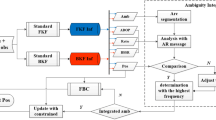Abstract
Techniques are described in this paper for improving the Ambiguity Function Method (AFM) for differential GPS positioning using phase observations, (a) that take advantage of optimal dual-frequency observable combinations to improve thereliability of the AFM, and (b) that significantly shorten the computation time necessary for the AFM. The procedure can be used for kinematic positioning applications if a Kalman filter predicted position is accurate enough as an initial position for the suggested AFM searching procedure, or pseudokinematic mode using say a triple-difference solution as an initial position for static positioning if the baseline length is short (typically <5km).
Similar content being viewed by others
References
Abidin HZ (1993) Computational and Geometrical Aspects of ‘On The Fly’ Ambiguity Resolution. Technical Report No. 164, Department of Surveying Engineering, University of New Brunswick, Fredericton, N.B., Canada.
Cocard M, Geiger A (1992) Systematic Search for all Possible Widelanes. In: Proceedings of The Sixth International Geodetic Symposium on Satellite Positioning, March 17–20, Columbus, Ohio, USA, pp 312–318.
Counselman CC, Gourevitch SA (1981) Miniature Interferometer Terminals for Earth Surveying: Ambiguity and Multipath with the Global Positioning System. IEEE Transactions on Geoscience and Remote Sensing, Vol. GE-19, No. 4, pp 244–252.
Han SW (1994a) Equivalence between the Ambiguity Function Method and the Least Squares Method with GPS Carrier Phase Observables and The Improved Ambiguity Function Method. ACTA GEODAETICA et CARTOGRAPHICA SINICA, Vol. 23, No. 4, pp 282–288.
Han SW (1994b) Ambiguity Function Method with Constrained Conditions and its Application in GPS Kinematic Positioning. Journal of Wuhan Technical University of Surveying and Mapping, Vol. 19, No. 1, pp 7–14.
Hofmann-Wellenhof B, Lichtenegger H, Collins J (1992) GPS Theory and Practice. Springer-Verlag Wien New York.
Lachapelle G, Cannon ME, Erickson C, Falkenberg W (1992) High Precision C/A Code Technology for Rapid Static DGPS Surveys. In: Proceedings of The Sixth International Geodetic Symposium on Satellite Positioning, March 17–20, Columbus, Ohio, USA, pp 165–173.
Mader GL (1990) Ambiguity Function Techniques for GPS Phase Initialization and Kinematic Solutions. In: Proceedings of Second International Symposium on Precise Positioning with the Global Positioning System, Ottawa, Canada, September 3–7, pp 1233–1247.
Mader GL (1992) Rapid Static and Kinematic Global Positioning System Solutions Using the Ambiguity Function Technique. Journal of Geophysical Research, Vol. 97, No. B3, pp 3271–3283.
Remondi BW (1984) Using the Global Positioning System (GPS) Phase Observable for Relative Geodesy: Modeling, Processing and Results. Doctoral Dissertation, Center for Space Research, University of Texas at Austin.
Remondi BW (1989) Pseudo-kinematic GPS Results Using the Ambiguity Function Method. Journal of The Institute of Navigation, Vol. 38, No. 1, pp 17–36.
Remondi BW, Hilla SA (1993) Pseudo-kinematic Surveying Based Upon Full-wavelength Dualfrequency GPS Observations. NOAA Technical Memorandum NOS NGS-56, November.
Seeber G (1993) Satellite Geodesy Foundations, Methods, and Applications. Walter de Gruyter.
Author information
Authors and Affiliations
Rights and permissions
About this article
Cite this article
Han, S., Rizos, C. Improving the computational efficiency of the ambiguity function algorithm. Journal of Geodesy 70, 330–341 (1996). https://doi.org/10.1007/BF00868185
Received:
Accepted:
Issue Date:
DOI: https://doi.org/10.1007/BF00868185




